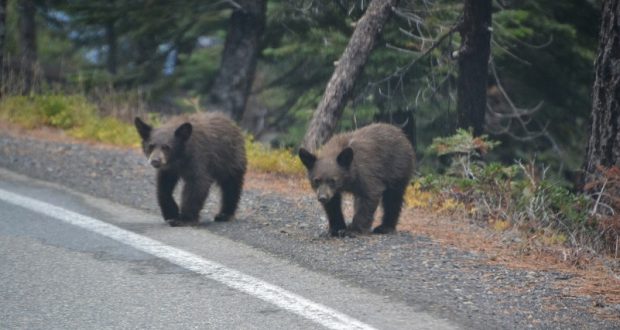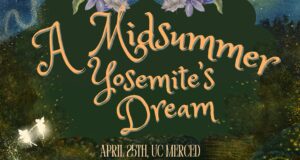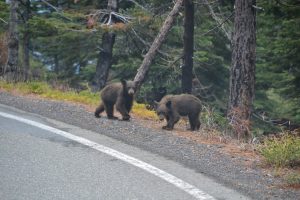 YOSEMITE — Anyone visiting Yosemite National Park is likely hoping for the chance to see bears. A recent trip up to the Empire Fire provided a delightful encounter with two bear cubs along the Glacier Point Road.
YOSEMITE — Anyone visiting Yosemite National Park is likely hoping for the chance to see bears. A recent trip up to the Empire Fire provided a delightful encounter with two bear cubs along the Glacier Point Road.
It was about 2:30 on Thursday afternoon, as I headed down from Bridalveil Campground. Just a mile or two west of the Yosemite Ski and Snowboard Area, a lone bear cub was sniffing around on the narrow shoulder of the road.
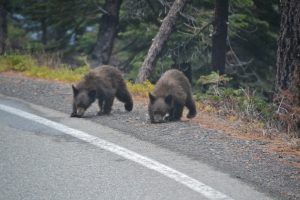 I stopped and grabbed my camera, just as another cub joined the first on the side of the road. I stayed in my car and began shooting photos through the windshield, as the two cubs continued their exploration at the edge of the pavement.
I stopped and grabbed my camera, just as another cub joined the first on the side of the road. I stayed in my car and began shooting photos through the windshield, as the two cubs continued their exploration at the edge of the pavement.
The approach of another vehicle from the other direction sent them scampering down the steep embankment, thankfully, as they had begun venturing farther into the roadway, and the uphill lane was a blind corner in the road.
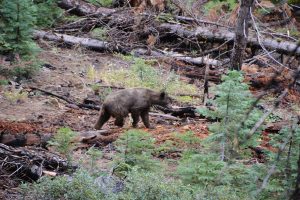 Once they had gone down into the forest, I cautiously peered over the edge of the bank, scanning for the mother who was sure to be close by. I spotted her down in the forest, foraging around some downed logs.
Once they had gone down into the forest, I cautiously peered over the edge of the bank, scanning for the mother who was sure to be close by. I spotted her down in the forest, foraging around some downed logs.
The two cubs gamboled around mom for a moment or two, and then bounded off deeper into the forest, followed closely by their mother.
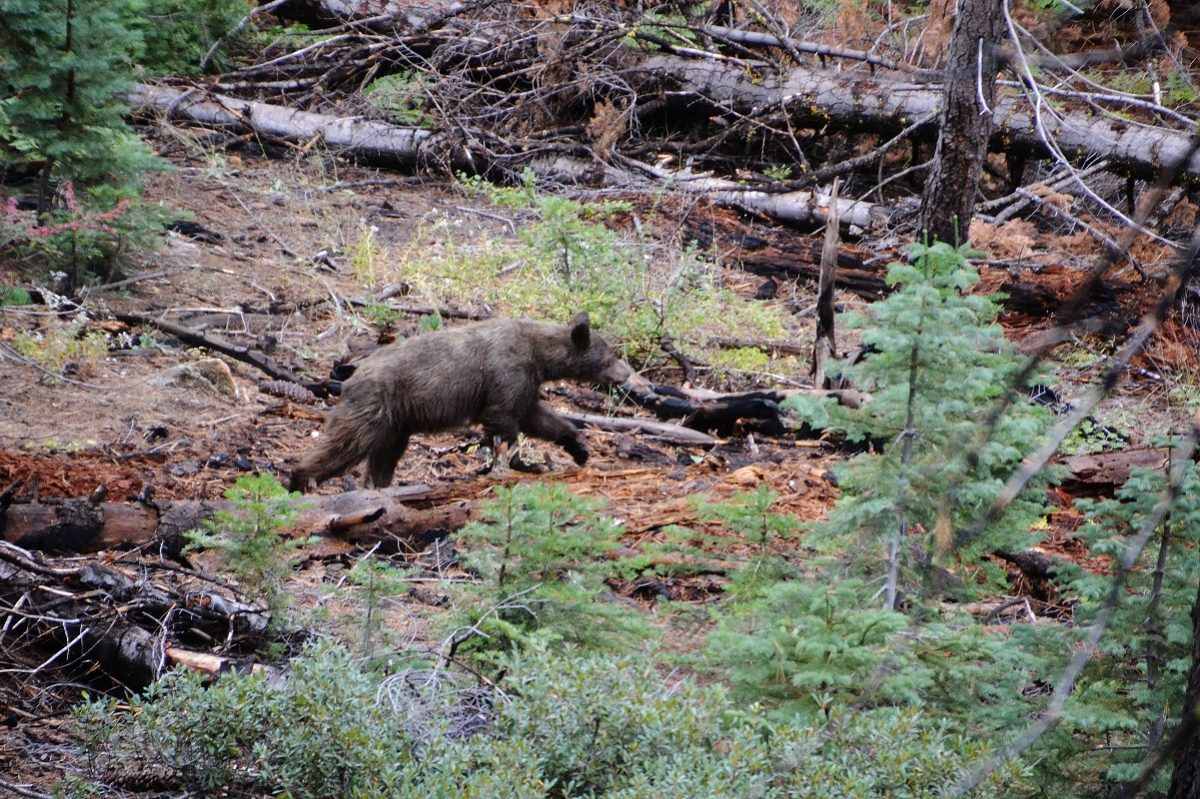
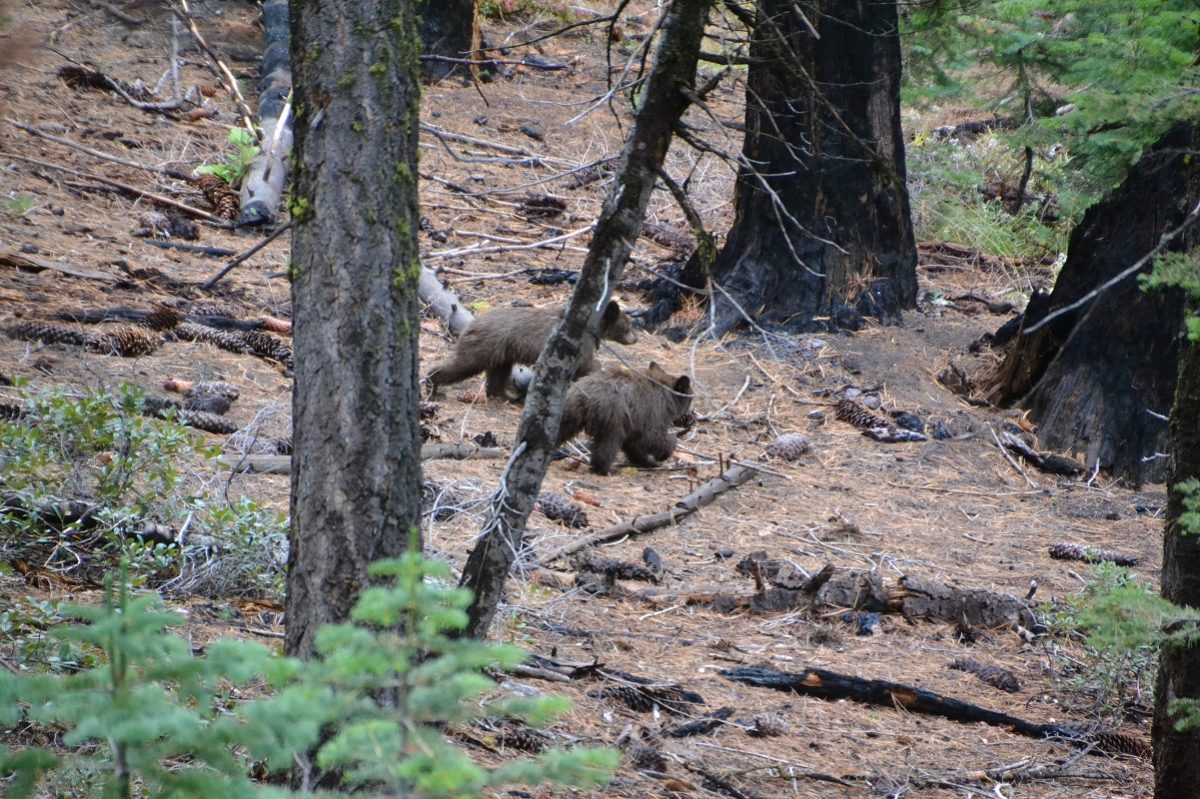
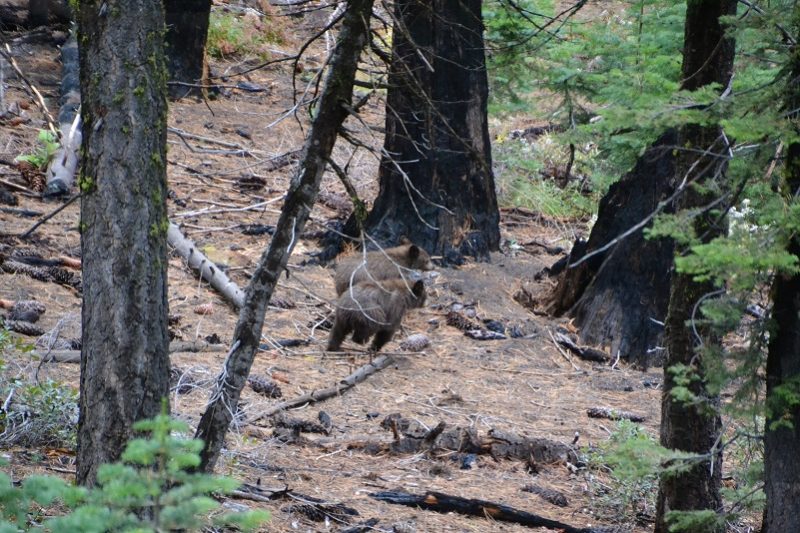
This brief encounter was a reminder of just how important that 35 mph speed limit is in the park. These cubs couldeasily have been hit by a car, as they explored along the roadway, unaware of the danger posed by passing motorists.
Here is some information about bears in the park from the Yosemite website:
Basic Biology
- Color: Most are not black but brown or even blond or reddish brown
- Weight: Average adult male is about 250 pounds and average adult female is about 150 pounds
- Diet: Mostly grasses and berries, with acorns as a favored food in the fall
- Hibernation: Reduced body temperature, pulse rate, and respiration conserve energy
- Reproduction: Females give birth while in hibernation to a litter of one to three cubs
- Young: Cubs remain with their mother until about 16 to 17 months of age
American black bears found in Yosemite National Park have long been of intense interest to park visitors and managers. Seeing one of the approximately 300 to 500 black bears in Yosemite can evoke excitement, awe, and fear.
If visitors spot a bear while in the park, it is a black bear-not a brown or grizzly bear. The last known grizzly bear was shot outside the Yosemite region in the early 1920s; the species no longer exists in California despite its presence on the California state flag.
When Euro-Americans arrived, they found a large population of grizzlies throughout the state. Grizzlies were perceived as a dire threat to life and property, and were killed in large numbers. By the early 1900s, few grizzlies and little of their prime habitat in the Central Valley remained. Black bears, in contrast to brown bears, have fared much better due to a combination of their greater adaptability around people and different habitat requirements.
Black bears fascinate wildlife enthusiasts due to their unique biology and behaviors. Most of Yosemite’s black bears, despite their name, are not black, but are brown in color. Truly black-colored black bears are rare in the west. Black bears vary greatly in size–the largest black bear captured in Yosemite weighed 690 pounds, which is much larger than the typical male found here that usually weighs around 250 pounds.
Bears weigh the most in fall when gorging on acorns and other seasonal foods. This enables them to gain fat and survive winter—consuming up to 20,000 calories a day (equal to a human eating 40 Big Mac sandwiches in a day). Bears hibernate in hollow trees or logs, under the root mass of a tree, or in caves formed by a jumble of large rocks. While hibernating, bears enter a state of reduced body temperature, pulse rate, and respiration that conserves energy, and do not defecate nor urinate, but can metabolically extract energy from body wastes. Their “sleep” is not a deep one. Black bears often leave the den periodically.
After emerging from winter dens, bears feed largely on meadow grasses, which are low in nutrition but sustain them until berries of various plant species ripen and other foods become available that provide higher calories. Bears also eat ants, termites, and insect larvae ripped out of logs or dug from the ground. The oldest bear known in Yosemite was a 32-year-old female first captured in the Tuolumne Meadows area in the 1980s.
Visitors who encounter a bear should keep their distance for safety and respect for themselves and the animal. If visitors see a black bear in undeveloped areas, they should remain at least 50 yards from it. If they encounter a bear in developed areas, they should stand their ground and scare the bear away by raising their arms and making very loud noises. Black bears may show dominance by bluff charging, especially when guarding food or cubs. Attacks are rare, and no one has been killed or seriously injured by a black bear in Yosemite.
‘Red Bear’ Signage
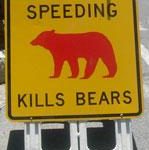 One of the most visible bear management tools is the “Red Bear-Dead Bear” signage. To minimize collisions between cars and wildlife in Yosemite National Park, an education initiative began in 2007. The red bear program aims to increase visitor awareness of the high frequency of vehicle-animal collisions, to encourage visitors to be aware of wildlife along roadsides, and to observe posted speed limits. Typically a dozen or more black bears are killed or maimed each year by vehicles; in 2010, 28 vehicle-bear collisions were reported.
One of the most visible bear management tools is the “Red Bear-Dead Bear” signage. To minimize collisions between cars and wildlife in Yosemite National Park, an education initiative began in 2007. The red bear program aims to increase visitor awareness of the high frequency of vehicle-animal collisions, to encourage visitors to be aware of wildlife along roadsides, and to observe posted speed limits. Typically a dozen or more black bears are killed or maimed each year by vehicles; in 2010, 28 vehicle-bear collisions were reported.
The program includes 18 metal signs, illustrated with a red bear, positioned off the road where collisions in the park occurred. The attention-grabbing sign design and coloration is based on recommendations from a 2003 Wyoming roadway and wildlife crossing study. It indicated that traditional wildlife crossing signs, such as a yellow diamond-shaped sign with a black leaping deer, are often ineffective in mitigating vehicle-animal collisions, but innovative signage of animal silhouettes, in conjunction with a public education and awareness campaign, can be effective.
Since the Yosemite project began, the park has received an increase in reports of vehicle-bears collisions, but it’s unclear to scientists if more bears have been hit by cars of if the sign campaign simply has encouraged the public to report collisions they witness. Yosemite’s signage project also includes educational displays, in the form of flyers and posters, at entrance stations, visitor centers, and stores. Evaluation of this program is still ongoing.
Do Your Part
Park managers attempt to preserve this species that can be negatively affected by humans. First, visitors should drive the speed limit, reminded by signage placed where a bear has been hit by a vehicle. Next, visitors should follow food storage regulations.
Bear management attitudes have changed since the early days of the park’s history when little was done to keep bears from becoming conditioned to human food. Decades ago, the National Park Service maintained several bear feeding areas in the park where bears were fed for the entertainment of park visitors.
When visiting Yosemite, visitors should expect black bears to attempt amazing acts to obtain human food. If food has been left in a car, bears will break vehicle windows, bend car frames, and pop open camper shells. To get into a trunk, they will enter the passenger area and claw through the back seat. Learn about Yosemite’s bear management and food storage regulations for campgrounds, trailheads, lodging and wilderness.

